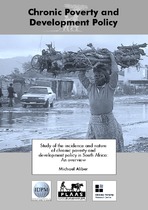| dc.description.abstract | The purpose of this study is fourfold: first, to summarise the current state of knowledge about chronic poverty in South Africa; second, to describe the range of existing governmental and civil society initiatives which address chronic poverty; third, to identify challenges to addressing chronic poverty in South Africa; and fourth, to identify themes for further research. For the purposes of this study, house-
holds or individuals are understood to be in chronic poverty when their condition of poverty endures over a period of time. Different researchers propose different time periods as characteristic of chronic poverty (for example, six months, ten years); this is usually taken to mean that the household or individual remains beneath the poverty line for all or virtually all of this period. Alternatively, and perhaps more meaningfully, chronic poverty can be understood as the inability of households or individuals, perhaps for lack of opportunity, to better their circumstances over time or to sustain themselves through difficult times. Chronic poverty can be a function of an individual’s characteristics (for example, elderly, disabled), or of the environment (for example, sustained periods of high unemployment, landlessness), or of a combination of the two. Indeed, a common scenario in South Africa involves the coincidence of poor health, meagre education, and fractured
families, on the one hand, with skewed resource distribution, inadequate infrastructure, and scarce employment opportunities, on the other. The combination is more than sufficient to trap many people in poverty. To date, there has been only one set of data collected in South Africa which allows an inter-temporal comparison among the same households. This is the KwaZulu-Natal Income Dynamics Study (KIDS) which, as the name implies, covers only one of South Africa’s nine provinces. Because this data set and the analyses based upon it are unique, we discuss it at length. One of the important findings from the KIDS data is that 22 per cent of the 1 200 African households that were sur-
veyed were poor in both 1993 and 1998.
This represents about two thirds of all households that were poor in 1993, and one half of those that were poor in 1998,
showing that at least half of those households that are poor, are chronically poor.
Another interesting finding is that ‘ultra- poverty’ is not synonymous with chronic poverty. In other words, a household that is just below the poverty line in one period is no more likely to move above the poverty line in the next period than a household that started off much further
below the poverty line. A key determinant of whether a household stays in poverty, escapes from poverty, or falls into poverty, is how that household fares in terms of employment. One of the surprising findings from the KIDS data set was the degree of employment volatility experienced by households. Notwithstanding the contribution of household income sources other than formal sector employment, employ-
ment apparently makes the difference between survival and total destitution, but less commonly associated with the difference between being poor and not being poor. Income sources outside the formal sector may make the difference between survival and total destitution, but are less likely to determine whether an individual or household is poor or not. The KIDS-based studies as well as other poverty analyses allow us to identify groups especially likely to be chronically poor. These include rural households, households headed by women, households
effectively headed by elderly people, and households headed by former (retrenched) farm workers. Over the next 10 years, however, AIDS orphans and households directly affected by AIDS will probably figure as the most prominent category of people trapped in chronic poverty. | en_US |

